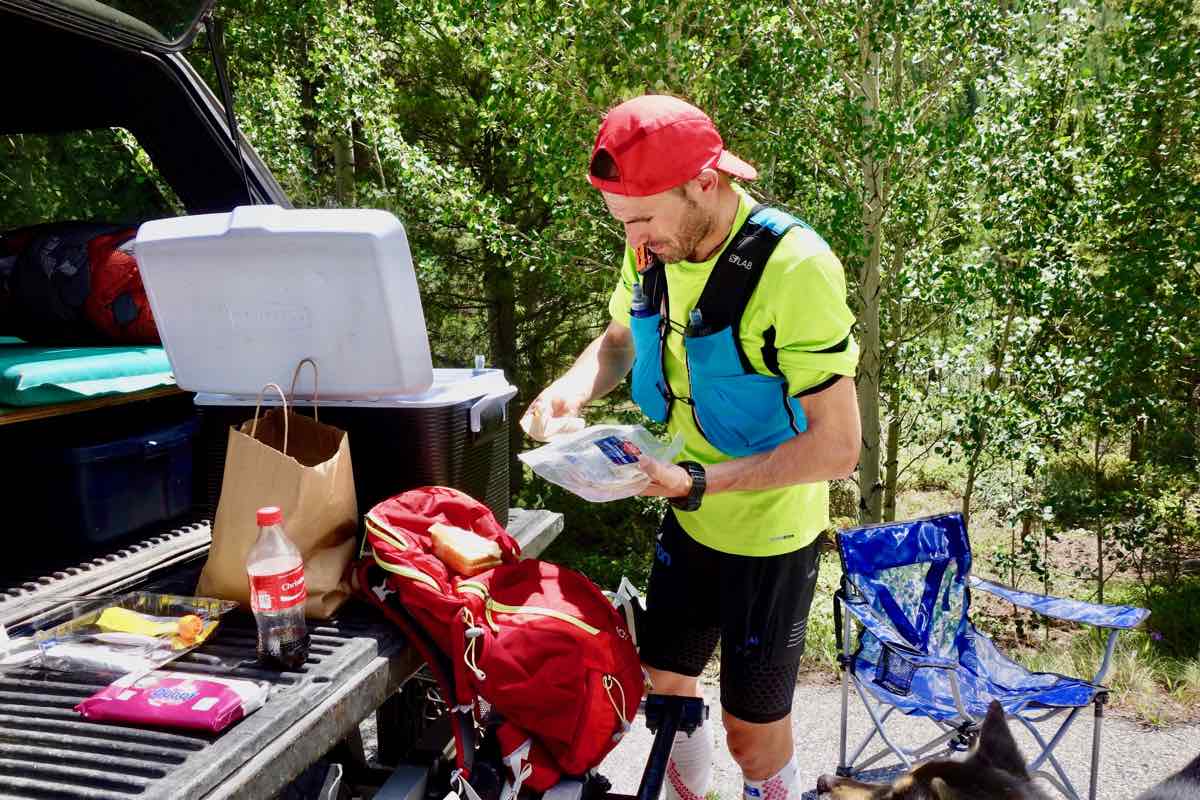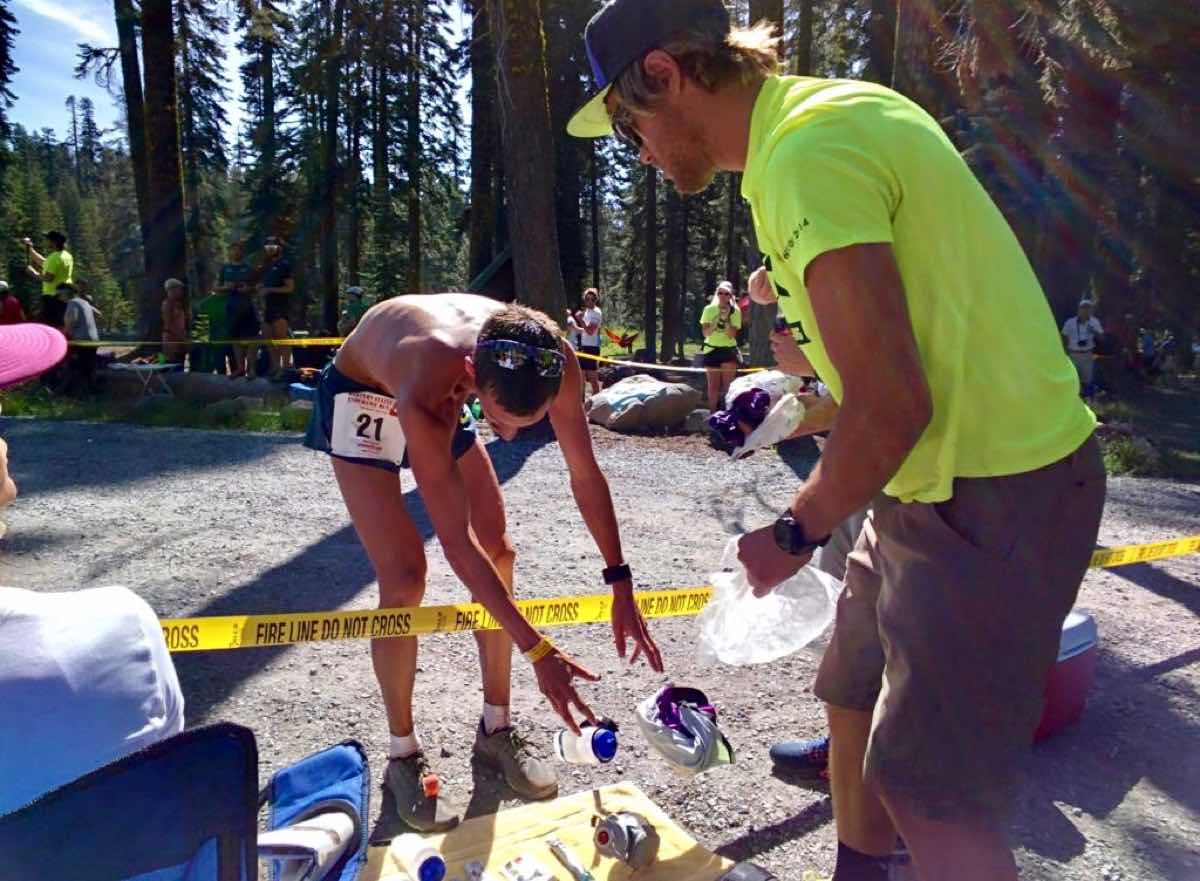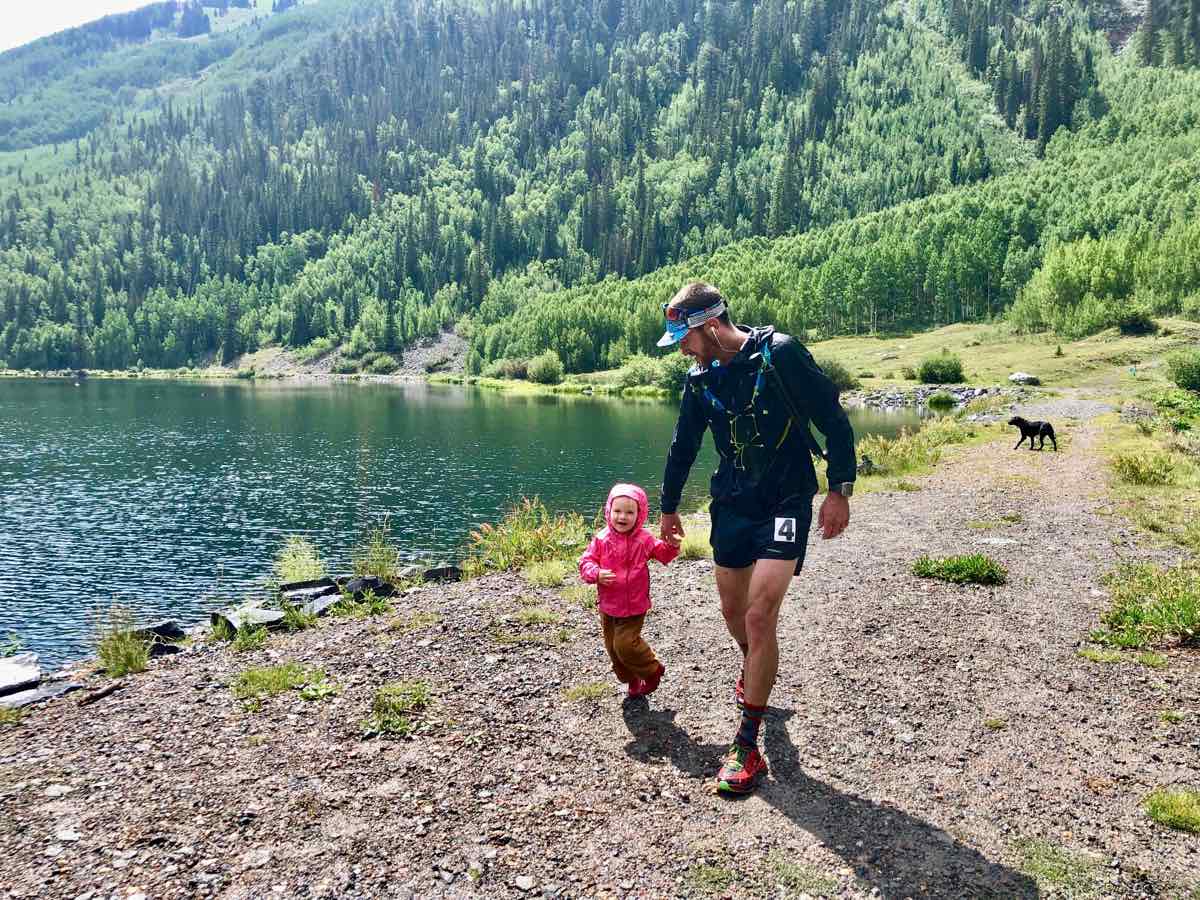If you are considering running your first ultramarathon, crewing a fellow runner for their race is a great way to get an idea of what you are in for. Or, if you have run a race yourself but you feel like you still have a lot to learn, watching someone else is a great way to do so. And, finally, crewing is just plain a fun way to spend the day with likeminded people!
The age-old method of ‘see one, do one, teach one’ is really applicable to trail running. Crewing a friend will allow you to ‘see one.’ You can immerse yourself in their experience while not being stuck in the ring against the ropes yourself. You get to help out a running partner and get a real taste of the highs and lows you will inevitably experience when you are in the hot seat.
As a crew member, you become a first-aid provider, counselor, cook, motivational speaker, pedicurist, and driver for a person who is exhausted, dirty, smelly, dehydrated, hungry, sleepy, blistered, and sunburned. Your runner could be riding the ultra high or grinding through rock bottom. They could be smiling and thanking everyone around or they could be acting like a petulant child. As a runner’s crew, you might have to rush from aid station to aid station and then wait for hours with no news, no cell service, and plenty of anxiety. And then, when your runner finally arrives, you may deliver to them a few packets of gel, a fresh water bottle, and a high five, all in the span of 30 seconds before they are gone again. Or your runner might stumble in with a sour belly in need of a full-system reboot before getting on with their race. Crewing is a dynamic, difficult, and rewarding job–you never know what’s going to happen!
What Exactly is Crewing?
Crewing is providing on-course support for a runner during a race at designated, crew-allowed aid stations. Not all races allow or need crew support, but many ultras allow some on-course support. This could take the form of helping with foot care, preparing food for the runner, having fresh clothing or shoes, and giving encouraging words. Crews can be one person or a team, but some experience in planning and problem solving is the essence of the job.
I have seen inexperienced crews allow the excitement of the day to influence their decision-making, rendering them unable to help their runner resolve stomach and energy issues. I’ve seen veteran crews simply hand off bottles and change runners’ shoes with no more than three words. Perfecting the process comes from doing, but preparation and problem solving are most of the battle.
Finally, it is vital that crews know and follow the race rules. Know what aid stations allow crew assistance, follow race volunteers’ instructions, and be respectful of other runners and crews. Failure to follow rules can lead to penalties for your runner.
What to Do Before Race Day
Create clear plans with your runner in the weeks or days before the event. Have a plan for race logistics including what your runner will want at each aid station, estimated times for each crew point, and your driving plan.
Discuss with your runner how they want to be cared for, talk openly about their strengths and weaknesses, and speak about what to do if they have stomach or body issues. Talk with your runner to find out what has or hasn’t worked in past races. Planning out the worst- and best-case scenarios can help runners and crews prepare for the unexpected on race day.
Prepare gear and food for both yourself and your runner in advance. Last-minute packing can cause unneeded stress–and you might forget something too!
Often races are held in areas with spotty phone service, so printing out a map puts the mind at ease. Google Maps also has a feature that allows you to download maps in advance so that they still function when you don’t have service. Check the routes and roads before you go, as Google may unfortunately send you on a logging road that hasn’t been used or maintained in years.
Having company when crewing can be really helpful, so find a mutual friend to help out with the driving or map reading.
Attend the pre-race runner briefing so that you are updated on any changes or rules.
What to on Do on Race Day
Take Care of Yourself
Following an ultra for a day (or more) likely requires that you get up early and spend most of the day outside in the same elements that your runner is facing. Crewing is its own kind of ultra! Eating, drinking, getting rest, and staying comfortable will allow you to best serve your runner. If you are tired and hungry, you will probably do a poor job of taking care of your runner. Pack a bag for yourself, and have plenty of food, fluids, and clothing for variety of weather conditions.
Jenn Shelton has been on both sides of the trail, having crewed many a runner and having been crewed herself. She explains, “I tell people to think of it like the announcement from the flight attendant about air masks dropping from the ceiling of an airplane in the unlikely event of a loss of cabin pressure. Secure your mask first, and then help the people around you. Crewing is really hard work, and your first and most important job is taking care of yourself. Then and only then concern yourself with the needs of your runner. The other reason that this is good (beyond the obvious that you can’t help someone if you aren’t your best self) is that your runner will perform better when they are self-sufficient. They are racing to feel their power, agency, and strength. If they go into a place of neediness or vulnerability, they will start to crack. If you are sitting there and wiping for them, you aren’t doing them any favors. Let them take care of themselves. That will give them power, as backward as that sounds.”
Expect the Unexpected
Be prepared for anything. There will be unforeseen challenges for your runner and you as crew. Does the weather flip all the time, especially in the mountains? Yes! Don’t be surprised when it’s raining and 35 degrees Fahrenheit rather than 70 and sunny. A wise runner once said, “That sounds about right.” Good preparation will allow you to calmly meet any unexpected adversity with a hearty, “That sounds about right.” The fact is, even with perfect planning and preparation, you may have to problem solve. When plans A, B, and C go out the window, be ready to get creative! The longer the race, the more likely this becomes.

Having a couple kinds of food and drink might help a runner who isn’t sure what they want to eat. Photo: iRunFar/Meghan Hicks
Be Organized and Light
As crew, you are probably carrying around a bag, water bottles, and maybe even a folding chair. Know where stuff is in those bags. If your runner requests sunscreen, don’t fumble around unzipping every pocket in search of it. Know where each item is and keep organized throughout the day. Keep the car, your runner’s backpack, and your mind uncluttered.
Don’t overpack, either. You may have to walk a mile or more to an aid station from the parking lot. Make lists of what you expect to need at each aid station before race day. This can help make sure you cover all the gear bases and don’t end up overpacked or underprepared. When you get to the aid station, you can use the list to lay out and ready the needed items. This also helps assure you don’t end up frantically running back to the car when you realize something crucial is in the trunk.
Be Cool Like a Cucumber
I’ve seen many a runner shuffle into a crew point to have an overly anxious crew smother them, shoving bananas into their mouth, frantically smearing nut butter on thighs, and spraying water everywhere with the urgency of a fire brigade while attempting to refill water bottles and cool their runner off. Now, I understand the sentiment, you have been waiting for hours and your runner finally emerges from the woods. It’s go time! But remember that your energy will influence your runner’s energy, so be chill, positive, fast, and efficient. Be calm and collected, read their body language, and listen to what they need. Send them back out on the course cool, confident, and ready for the next miles.
Tough Love
Your job is keeping your runner safe, supported, and encouraged. Hopefully that allows them to make it to the finish line. You may have to kick them out of the folding camp chair and send them back out onto a trail when they just want to lay down and quit. You may also have to be the voice of reason and encourage your runner to drink fluids or eat a banana they can’t imagine stomaching.
If Things Go Sort of Bad
Ethan Newberry (the Ginger Runner) has crewed at a variety of events, including the Barkley Marathons and Western States 100. When things get rough, he recommends, “No negativity. While I think it’s good to allow your runner to talk through all the pain and suffering, don’t dwell on it. If they’re having a tough time, I like to give them one opportunity to vent everything that sucks. This not only gives me a checklist to be aware of, but it also increases the chance of focusing their attention on something new and positive. If you find your runner really wants to dwell on the negative, ask them to remember one of their favorite parts of the day. Or give them something to look forward to. Hell, just tell a funny story. The goal is also to keep a smile on your face in hopes it becomes contagious.”
If Things Go Really Bad
There is a spectrum of damage that can occur to a runner during an ultra. On one end are blisters, chafing, soreness, and general fatigue–the normal stuff. On the other side are seriously sprained ankles, an altered mental state, symptoms of heat illness, and plenty of other major issues. All these problems are not normal. As beginner trail runners and crew, it can occasionally be hard to tell what side an issue falls on.
Sometimes you need to simply look your runner in the eyes. Dr. Bob Lind, the former Western States 100 medical director, determined a distressed runner’s true state by “looking into his eyes to see if his soul had separated from his body.” The safety of your runner is your number-one priority. If you are a beginner runner, you may not be familiar with the severity of the ultra experience. Getting a veteran trail runner or medical volunteer to help assess your runner’s capacity to continue and/or finish may be helpful if there is question as to the safety of your runner continuing on.
What to Do After Race Day
Learn from the experience of the day. Let your runner defrag with you after the race. Listen to what went well and what went poorly. Look at what food/gear you ran out of and what you thought you might use and didn’t touch. Take some notes!
We have all said, “Oh man, that person went out way too hard!” But then at our next race we go out charging in the excitement of the day and throw pacing to the wind. If we allow ourselves, we can learn as much from watching others, like while we are crewing, as we do when we are running ourselves! Write down what you learn and read it before your next race.
Don’t Overthink it
Even if you haven’t crewed a trail race before, you have no doubt supported friends and family in many ways. You can and will be an awesome crew! Listen to your runner. Provide a smile, some care, and help them fill their bottles/pack. Be prepared for literally anything. Keep a positive attitude when things get really tough for your runner.
It’s a pretty simple gig! Having a front-row seat to the ultra chaos/excitement will undoubtedly give you a decent idea of what you are getting yourself into if you have never run an ultra before. And if you have, hopefully it gives you a new or clearer perspective on how to execute better and smarter in your own next race or adventure!
Call for Comments (from Meghan)
- What was your first crewing experience like? What went well and what didn’t?
- What have you learned about your own running through crewing others?
- What crewing tips and tricks can you add to those provided here?



